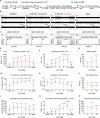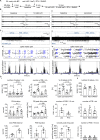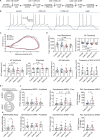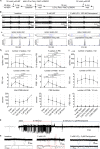Differential acute impact of therapeutically effective and overdose concentrations of lithium on human neuronal single cell and network function
- PMID: 33980815
- PMCID: PMC8115174
- DOI: 10.1038/s41398-021-01399-3
Differential acute impact of therapeutically effective and overdose concentrations of lithium on human neuronal single cell and network function
Abstract
Lithium salts are used as mood-balancing medication prescribed to patients suffering from neuropsychiatric disorders, such as bipolar disorder and major depressive disorder. Lithium salts cross the blood-brain barrier and reach the brain parenchyma within few hours after oral application, however, how lithium influences directly human neuronal function is unknown. We applied patch-clamp and microelectrode array technology on human induced pluripotent stem cell (iPSC)-derived cortical neurons acutely exposed to therapeutic (<1 mM) and overdose concentrations (>1 mM) of lithium chloride (LiCl) to assess how therapeutically effective and overdose concentrations of LiCl directly influence human neuronal electrophysiological function at the synapse, single-cell, and neuronal network level. We describe that human iPSC-cortical neurons exposed to lithium showed an increased neuronal activity under all tested concentrations. Furthermore, we reveal a lithium-induced, concentration-dependent, transition of regular synchronous neuronal network activity using therapeutically effective concentration (<1 mM LiCl) to epileptiform-like neuronal discharges using overdose concentration (>1 mM LiCl). The overdose concentration lithium-induced epileptiform-like activity was similar to the epileptiform-like activity caused by the GABAA-receptor antagonist. Patch-clamp recordings reveal that lithium reduces action potential threshold at all concentrations, however, only overdose concentration causes increased frequency of spontaneous AMPA-receptor mediated transmission. By applying the AMPA-receptor antagonist and anti-epileptic drug Perampanel, we demonstrate that Perampanel suppresses lithium-induced epileptiform-like activity in human cortical neurons. We provide insights in how therapeutically effective and overdose concentration of lithium directly influences human neuronal function at synapse, a single neuron, and neuronal network levels. Furthermore, we provide evidence that Perampanel suppresses pathological neuronal discharges caused by overdose concentrations of lithium in human neurons.
Conflict of interest statement
S.I. received financial support from EISAI to conduct research. EISAI was not involved or influencing study design, data acquisition, and interpretation. S.I. holds a position at the company Cellectricon. Cellectricon was not involved in the study, and all experiments and data analysis were conducted at the Sahlgrenska Academy at the University of Gothenburg. S.T. is founder of the company Result Medical GmbH, Düsseldorf, Germany. The remaining authors declare no conflict of interest.
Figures





Similar articles
-
Astrocyte lineage cells are essential for functional neuronal differentiation and synapse maturation in human iPSC-derived neural networks.Glia. 2019 Oct;67(10):1893-1909. doi: 10.1002/glia.23666. Epub 2019 Jun 27. Glia. 2019. PMID: 31246351
-
Human induced pluripotent stem cell (hiPSC)-derived neurons respond to convulsant drugs when co-cultured with hiPSC-derived astrocytes.Toxicology. 2017 Aug 15;389:130-138. doi: 10.1016/j.tox.2017.06.010. Epub 2017 Jun 28. Toxicology. 2017. PMID: 28666936
-
Differential responses to lithium in hyperexcitable neurons from patients with bipolar disorder.Nature. 2015 Nov 5;527(7576):95-9. doi: 10.1038/nature15526. Epub 2015 Oct 28. Nature. 2015. PMID: 26524527 Free PMC article.
-
[Neuroprotective actions of lithium].Seishin Shinkeigaku Zasshi. 2003;105(1):81-6. Seishin Shinkeigaku Zasshi. 2003. PMID: 12701214 Review. Japanese.
-
[Antipsychotics in bipolar disorders].Encephale. 2004 Sep-Oct;30(5):417-24. doi: 10.1016/s0013-7006(04)95456-5. Encephale. 2004. PMID: 15627046 Review. French.
Cited by
-
Actionable Genomics in Clinical Practice: Paradigmatic Case Reports of Clinical and Therapeutic Strategies Based upon Genetic Testing.Genes (Basel). 2022 Feb 10;13(2):323. doi: 10.3390/genes13020323. Genes (Basel). 2022. PMID: 35205368 Free PMC article.
-
Functional Characterization of Human Pluripotent Stem Cell-Derived Models of the Brain with Microelectrode Arrays.Cells. 2021 Dec 29;11(1):106. doi: 10.3390/cells11010106. Cells. 2021. PMID: 35011667 Free PMC article. Review.
-
Using Human-Induced Pluripotent Stem Cell Derived Neurons on Microelectrode Arrays to Model Neurological Disease: A Review.Adv Sci (Weinh). 2023 Nov;10(33):e2301828. doi: 10.1002/advs.202301828. Epub 2023 Oct 20. Adv Sci (Weinh). 2023. PMID: 37863819 Free PMC article. Review.
-
Association between urinary metals and prostate-specific antigen in aging population with depression: a cross-sectional study.Front Public Health. 2024 May 23;12:1401072. doi: 10.3389/fpubh.2024.1401072. eCollection 2024. Front Public Health. 2024. PMID: 38846601 Free PMC article.
-
High-Frequency Oscillations and Epileptogenic Network.Curr Neuropharmacol. 2022 Aug 3;20(9):1687-1703. doi: 10.2174/1570159X19666210908165641. Curr Neuropharmacol. 2022. PMID: 34503414 Free PMC article.
References
Publication types
MeSH terms
Substances
Grants and funding
LinkOut - more resources
Full Text Sources
Other Literature Sources

